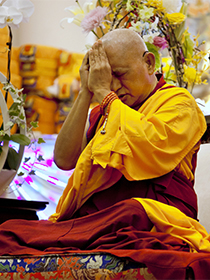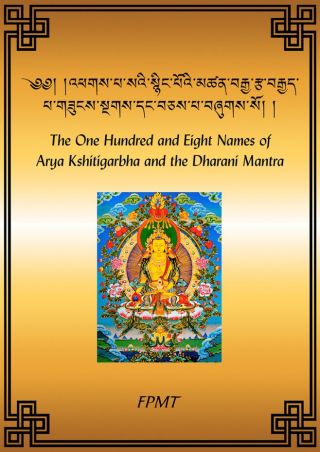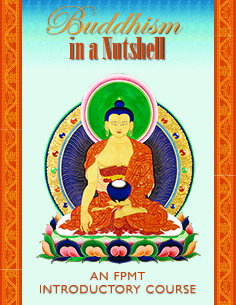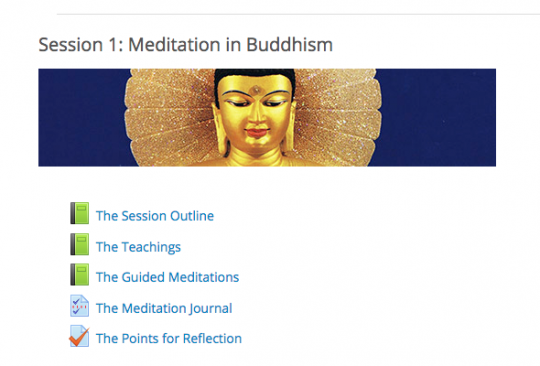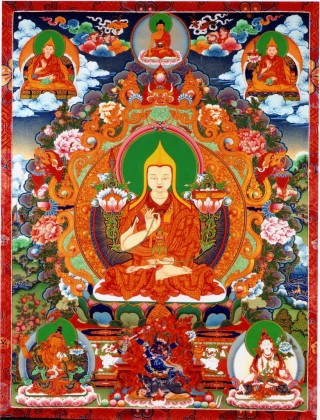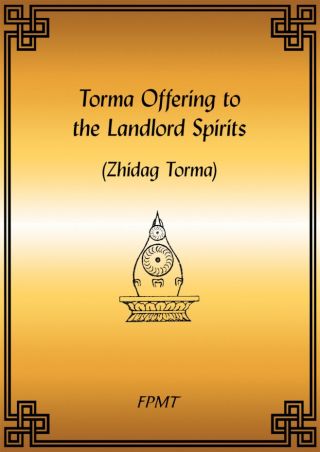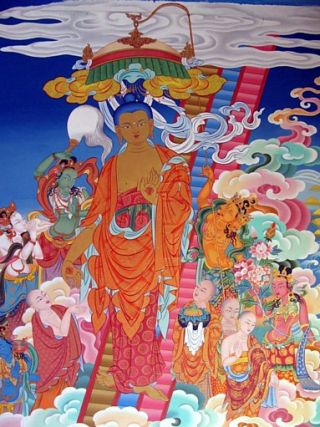- Home
- FPMT Homepage
Foundation for the Preservation of the Mahayana Tradition
The FPMT is an organization devoted to preserving and spreading Mahayana Buddhism worldwide by creating opportunities to listen, reflect, meditate, practice and actualize the unmistaken teachings of the Buddha and based on that experience spreading the Dharma to sentient beings. We provide integrated education through which people’s minds and hearts can be transformed into their highest potential for the benefit of others, inspired by an attitude of universal responsibility and service. We are committed to creating harmonious environments and helping all beings develop their full potential of infinite wisdom and compassion. Our organization is based on the Buddhist tradition of Lama Tsongkhapa of Tibet as taught to us by our founders Lama Thubten Yeshe and Lama Thubten Zopa Rinpoche.
- Willkommen
Die Stiftung zur Erhaltung der Mahayana Tradition (FPMT) ist eine Organisation, die sich weltweit für die Erhaltung und Verbreitung des Mahayana-Buddhismus einsetzt, indem sie Möglichkeiten schafft, den makellosen Lehren des Buddha zuzuhören, über sie zur reflektieren und zu meditieren und auf der Grundlage dieser Erfahrung das Dharma unter den Lebewesen zu verbreiten.
Wir bieten integrierte Schulungswege an, durch denen der Geist und das Herz der Menschen in ihr höchstes Potential verwandelt werden zum Wohl der anderen – inspiriert durch eine Haltung der universellen Verantwortung und dem Wunsch zu dienen. Wir haben uns verpflichtet, harmonische Umgebungen zu schaffen und allen Wesen zu helfen, ihr volles Potenzial unendlicher Weisheit und grenzenlosen Mitgefühls zu verwirklichen.
Unsere Organisation basiert auf der buddhistischen Tradition von Lama Tsongkhapa von Tibet, so wie sie uns von unseren Gründern Lama Thubten Yeshe und Lama Thubten Zopa Rinpoche gelehrt wird.
- Bienvenidos
La Fundación para la preservación de la tradición Mahayana (FPMT) es una organización que se dedica a preservar y difundir el budismo Mahayana en todo el mundo, creando oportunidades para escuchar, reflexionar, meditar, practicar y actualizar las enseñanzas inconfundibles de Buda y en base a esa experiencia difundir el Dharma a los seres.
Proporcionamos una educación integrada a través de la cual las mentes y los corazones de las personas se pueden transformar en su mayor potencial para el beneficio de los demás, inspirados por una actitud de responsabilidad y servicio universales. Estamos comprometidos a crear ambientes armoniosos y ayudar a todos los seres a desarrollar todo su potencial de infinita sabiduría y compasión.
Nuestra organización se basa en la tradición budista de Lama Tsongkhapa del Tíbet como nos lo enseñaron nuestros fundadores Lama Thubten Yeshe y Lama Zopa Rinpoche.
A continuación puede ver una lista de los centros y sus páginas web en su lengua preferida.
- Bienvenue
L’organisation de la FPMT a pour vocation la préservation et la diffusion du bouddhisme du mahayana dans le monde entier. Elle offre l’opportunité d’écouter, de réfléchir, de méditer, de pratiquer et de réaliser les enseignements excellents du Bouddha, pour ensuite transmettre le Dharma à tous les êtres. Nous proposons une formation intégrée grâce à laquelle le cœur et l’esprit de chacun peuvent accomplir leur potentiel le plus élevé pour le bien d’autrui, inspirés par le sens du service et une responsabilité universelle. Nous nous engageons à créer un environnement harmonieux et à aider tous les êtres à épanouir leur potentiel illimité de compassion et de sagesse. Notre organisation s’appuie sur la tradition guéloukpa de Lama Tsongkhapa du Tibet, telle qu’elle a été enseignée par nos fondateurs Lama Thoubtèn Yéshé et Lama Zopa Rinpoché.
Visitez le site de notre Editions Mahayana pour les traductions, conseils et nouvelles du Bureau international en français.
Voici une liste de centres et de leurs sites dans votre langue préférée
- Benvenuto
L’FPMT è un organizzazione il cui scopo è preservare e diffondere il Buddhismo Mahayana nel mondo, creando occasioni di ascolto, riflessione, meditazione e pratica dei perfetti insegnamenti del Buddha, al fine di attualizzare e diffondere il Dharma fra tutti gli esseri senzienti.
Offriamo un’educazione integrata, che può trasformare la mente e i cuori delle persone nel loro massimo potenziale, per il beneficio di tutti gli esseri, ispirati da un’attitudine di responsabilità universale e di servizio.
Il nostro obiettivo è quello di creare contesti armoniosi e aiutare tutti gli esseri a sviluppare in modo completo le proprie potenzialità di infinita saggezza e compassione.
La nostra organizzazione si basa sulla tradizione buddhista di Lama Tsongkhapa del Tibet, così come ci è stata insegnata dai nostri fondatori Lama Thubten Yeshe e Lama Zopa Rinpoche.
Di seguito potete trovare un elenco dei centri e dei loro siti nella lingua da voi prescelta.
- 欢迎 / 歡迎
简体中文
“护持大乘法脉基金会”( 英文简称:FPMT。全名:Foundation for the Preservation of the Mahayana Tradition) 是一个致力于护持和弘扬大乘佛法的国际佛教组织。我们提供听闻,思维,禅修,修行和实证佛陀无误教法的机会,以便让一切众生都能够享受佛法的指引和滋润。
我们全力创造和谐融洽的环境, 为人们提供解行并重的完整佛法教育,以便启发内在的环宇悲心及责任心,并开发内心所蕴藏的巨大潜能 — 无限的智慧与悲心 — 以便利益和服务一切有情。
FPMT的创办人是图腾耶喜喇嘛和喇嘛梭巴仁波切。我们所修习的是由两位上师所教导的,西藏喀巴大师的佛法传承。
繁體中文
護持大乘法脈基金會”( 英文簡稱:FPMT。全名:Found
ation for the Preservation of the Mahayana Tradition ) 是一個致力於護持和弘揚大乘佛法的國際佛教組織。我們提供聽聞, 思維,禪修,修行和實證佛陀無誤教法的機會,以便讓一切眾生都能 夠享受佛法的指引和滋潤。 我們全力創造和諧融洽的環境,
為人們提供解行並重的完整佛法教育,以便啟發內在的環宇悲心及責 任心,並開發內心所蘊藏的巨大潛能 — 無限的智慧與悲心 – – 以便利益和服務一切有情。 FPMT的創辦人是圖騰耶喜喇嘛和喇嘛梭巴仁波切。
我們所修習的是由兩位上師所教導的,西藏喀巴大師的佛法傳承。 察看道场信息:
- FPMT Homepage
- News/Media
-
- Study & Practice
-
-
- About FPMT Education Services
- Latest News
- Programs
- New to Buddhism?
- Buddhist Mind Science: Activating Your Potential
- Heart Advice for Death and Dying
- Discovering Buddhism
- Living in the Path
- Exploring Buddhism
- FPMT Basic Program
- FPMT Masters Program
- FPMT In-Depth Meditation Training
- Maitripa College
- Lotsawa Rinchen Zangpo Translator Program
- Universal Education for Compassion & Wisdom
- Online Learning Center
-
- Prayers & Practice Materials
- Overview of Prayers & Practices
- Full Catalogue of Prayers & Practice Materials
- Explore Popular Topics
- Benefiting Animals
- Chenrezig Resources
- Death & Dying Resources
- Lama Chopa (Guru Puja)
- Lama Zopa Rinpoche: Compendium of Precious Instructions
- Lama Zopa Rinpoche: Life Practice Advice
- Lama Zopa Rinpoche Practice Series
- Lamrim Resources
- Mantras
- Prayer Book Updates
- Purification Practices
- Sutras
- Thought Transformation (Lojong)
- Audio Materials
- Dharma Dates - Tibetan Calendar
- Translation Services
- Publishing Services
- Ways to Offer Support
- Prayers & Practice Materials
-
- Teachings and Advice
- Find Teachings and Advice
- Lama Zopa Rinpoche Advice Page
- Lama Zopa Rinpoche: Compendium of Precious Instructions
- Lama Zopa Rinpoche Video Teachings
- ༧སྐྱབས་རྗེ་བཟོད་པ་རིན་པོ་ཆེ་མཆོག་ནས་སྩལ་བའི་བཀའ་སློབ་བརྙན་འཕྲིན།
- Podcasts
- Lama Yeshe Wisdom Archive
- Buddhism FAQ
- Dharma for Young People
- Resources on Holy Objects
- Teachings and Advice
-
-
*If a menu item has a submenu clicking once will expand the menu clicking twice will open the page.
-
-
- Centers
-
- Teachers
-
- Projects
-
-
-
-
*If a menu item has a submenu clicking once will expand the menu clicking twice will open the page.
-
-
- FPMT
-
-
-
-
-
Live with compassion. Work with compassion. Die with compassion. Meditate with compassion. Enjoy with compassion. When problems come, experience them with compassion.
Lama Zopa Rinpoche
-
-
-
- Shop
-
-
-
The Foundation Store is FPMT’s online shop and features a vast selection of Buddhist study and practice materials written or recommended by our lineage gurus. These items include homestudy programs, prayers and practices in PDF or eBook format, materials for children, and other resources to support practitioners.
Items displayed in the shop are made available for Dharma practice and educational purposes, and never for the purpose of profiting from their sale. Please read FPMT Foundation Store Policy Regarding Dharma Items for more information.
-
-
Study & Practice News
10
Students can now find The One Hundred and Eight Names of Arya Kshitigarbha and the Dharani Mantra in PDF and ebook formats in the Foundation Store.
The recitation of the 108 names of Kshitigarbha and the associated dharani bestows good qualities, removes obstacles, and ultimately acts as a cause for the attainment of liberation.
Lama Zopa Rinpoche recommended reciting this text in order to help pacify the wildfires in California in 2018.
Find The One Hundred and Eight Names of Arya Kshitigarbha and the Dharani Mantra by donation in the Foundation Store:
https://shop.fpmt.org/The-One-Hundred-and-Eight-Names-of-Arya-Kshitigarbha-and-the-Dharani-Mantra-eBook-PDF_p_3187.html
Through comprehensive study programs, practice materials, and training seminars, FPMT Education nourishes the development of compassion, wisdom, kindness, and true happiness in individuals of all ages.
- Tagged: kshitigarbha, natural disasters
3
Take a Look! Buddha’s Teachings on Our Lives Card
Lama Zopa Rinpoche composed, translated, and drew the mantra calligraphy on the Buddha’s Teachings on Our Lives card as a reminder about the central role karma plays in our lives and experience.
The card reads: “As the Founder, the Omniscient One, Shakyamuni Buddha said in the Hundreds of Actions Sutra: ‘One who always becomes habituated and familiar with nonvirtue will in the future depend on nonvirtue, engage in nonvirtue, and be reborn following nonvirtue again.’ We should relate what Buddha said to the future effect of the virtuous karma we create also. Therefore please enjoy Dharma happiness all the time.”
The mantra at the bottom of the card comes from the sutra Phagpa Chulung Rolpai Do, and which just by seeing, purifies 100,000 eons of negative karma and obscurations. At the specific request of Lama Zopa Rinpoche, Lhadri Gelek Sherpa designed the card’s frame using Rinpoche’s altar at Kopan Monastery in Nepal.
Find the Buddha’s Teachings on Our Lives card by donation in the Foundation Store:
https://shop.fpmt.org/Buddhas-Teachings-on-Our-Lives-Card_p_1942.html
Through comprehensive study programs, practice materials, and training seminars, FPMT Education nourishes the development of compassion, wisdom, kindness, and true happiness in individuals of all ages.
13
Updated! Buddhist Meditation 101 and Buddhism in a Nutshell
Two introductory online FPMT education courses—Buddhist Meditation 101 and Buddhism in a Nutshell—have recently been revised and are now available to new students as well as to all current and past online course participants. The courses are taught by FPMT registered teachers Ven. Connie Miller and Ven. Amy Miller, respectively.
These online course materials are now available to be listened to or read directly online—whether on a smartphone, tablet, or computer—in addition to still being available as downloadable MP3 and PDF bundles.
Materials in Buddhist Meditation 101 have been reorganized to make them easier to navigate. Students begin the course with the session outline to get an overview of the topics and meditations covered in the session. Later, they can listen to the audio recordings or read the transcript of the teachings; listen to or read guided meditations; make some notes at the end of each meditation session in their meditation journal; and then contemplate the teachings more deeply by thinking about the questions found in the points for reflection. Students who wish to do so can share their comments on the points for reflection with a course elder and can also discuss their thoughts with other students on a discussion forum.
Buddhism in a Nutshell has also similarly been restructured. In addition, the teachings and guided meditations are also accompanied by readings and meditations from the book Buddhism in a Nutshell: Essentials for Practice and Study. This book, which includes many wonderful teachings by Lama Zopa Rinpoche and Lama Thubten Yeshe, is available to all course participants.
Find more information about Buddhist Meditation 101 and Buddhism in a Nutshell in the Foundation Store:
https://shop.fpmt.org/Buddhist-Meditation-101-Online_p_2332.html
https://shop.fpmt.org/Buddhism-in-a-Nutshell-Online_p_2596.html
FPMT centers, projects, and services are encouraged to host these two introductory courses using these online course materials. For more information about how this might work for your group, please contact the Foundational Program Coordinator at fpc@fpmt.org.
Through comprehensive study programs, practice materials, and training seminars, FPMT Education nourishes the development of compassion, wisdom, kindness, and true happiness in individuals of all ages.
- Tagged: buddhism in a nutshell, buddhist meditation 101, meditation 101, online learning center, ven. amy miller, ven. connie miller
6
Learn How to Chant Lama Chöpa
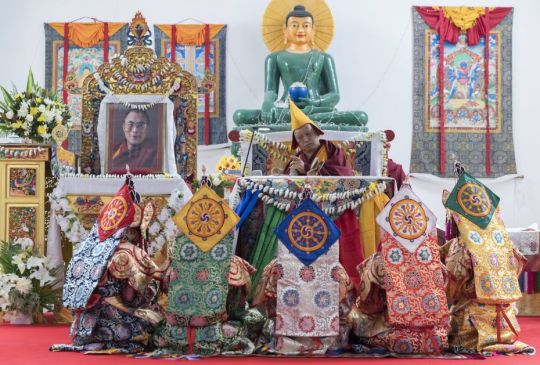
Lama Zopa Rinpoche presiding over Lama Chöpa. The five dakinis are also shown with the Jade Buddha for Universal Peace in the background. The Great Stupa of Universal Compassion, Bendigo, Australia, May 2018. Photo by Ven. Lobsang Sherab.
Students can find audio and video recordings of Lama Zopa Rinpoche and Ven. Thubten Dechen chanting Lama Chöpa, an essential FPMT practice, on FPMT.org.
During a 2014 retreat in Australia, Rinpoche taught fast-paced, medium-paced, and slow-paced tunes for Lama Chöpa, all of which are available for download or to watch online.
Ven. Thubten Dechen’s audio recordings took place over two sessions during the retreat in Bendigo, Australia during March-May 2018 and are now available online. Page references within the recording refer to the FPMT Retreat Prayer Book, 2016 edition. Lama Zopa Rinpoche frequently recommends students to learn from these recordings.
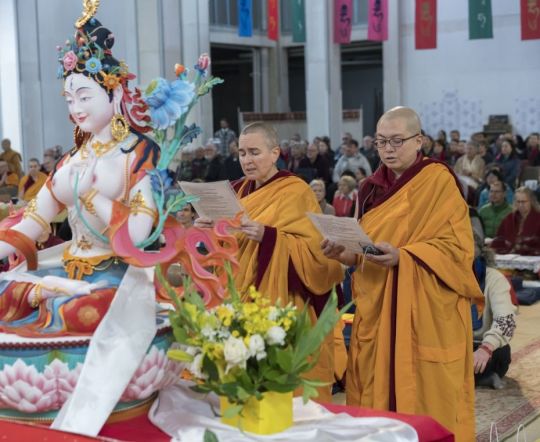
Ven. Gyalten Wangmo and Ven. Thubten Dechen offering the long life prayer composed by Khadro-la (Rangjung Neljorma Khandro Namsel Drönme) to Lama Zopa Rinpoche during the long life puja, Bendigo, Australia, May 2018. Photo by Ven. Lobsang Sherab.
Students can find Ven. Thubten Dechen’s audio recording of Lama Chöpa tunes and other Lama Chöpa resources in the Foundation Store:
https://shop.fpmt.org/Lama-Chopa-Tunes–MP3-Download_p_1645.html
https://shop.fpmt.org/search.asp?keyword=lama+chopa&search=
Through comprehensive study programs, practice materials, and training seminars, FPMT Education nourishes the development of compassion, wisdom, kindness, and true happiness in individuals of all ages.
- Tagged: lama chopa, lama chopa tunes
29
Lama Tsongkhapa Day (Ganden Ngamchoe) Is on December 2
Ganden Ngamchoe, literally “Ganden Offering of the Twenty-Fifth Day,” or Lama Tsongkhapa Day, is a celebration of the anniversary of Lama Tsongkhapa’s parinirvana. It is celebrated on the 25th day of the 10th month of the Tibetan calendar. This year, Lama Tsongkhapa Day falls on Sunday, December 2.
There are many practices you can organize to celebrate and create merit on this special day!
The main practice, recommended by Lama Zopa Rinpoche, is Lama Chopa. If you are unable to arrange Lama Chopa, Lama Tsongkhapa Guru Yoga is also recommended.
Here are some additional prayers and practices recommended by Rinpoche for students to recite as they are able:
English:
The Thousand Offerings to Lama Tsongkhapa
Extensive Offering Practice by Lama Zopa Rinpoche
“The Glorious One of the Three Worlds” (“Palden Sasumma”) by Ven. Gelek Pel Sangpo
“A Hymn of Experience” by Lama Tsongkhapa
“Destiny Fulfilled” by Lama Tsongkhapa
“Prayer for the Flourishing of Je Tsongkhapa’s Teachings” by Gungtang Tanpai Dronme
Lama Tsongkhapa’s Secret Biography by Khedrub Je
“Dependent Arising: A Praise to the Buddha” by Lama Tsongkhapa
“The Abbreviated Points of the Graded Path” by Lama Tsongkhapa
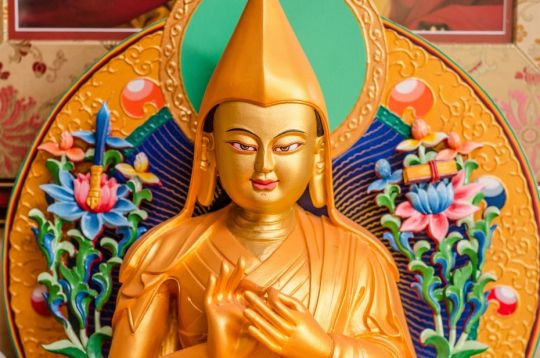
Statue of Lama Tsongkhapa at Kachoe Dechen Ling, Lama Zopa Rinpoche’s home in California, 2015. Photo by Chris Majors.
French:
French materials, including “Prière pour le développement de Lama Tsongkhapa” and “Hymne au Bouddha Shakyamouni pour son enseignement sur la production dépendante,” are available through the Service de traduction de la FPMT.
Tibetan:
The Thousand Offerings to Lama Tsongkhapa
“Palden Sasumma” (“Glory of the Triple Ground”)
Lama Tsongkhapa’s Secret Biography
On FPMT.org, you can read a teaching by Lama Zopa Rinpoche about how to carry out these practices on Lama Tsongkhapa Day.
Learn about how to celebrate Lama Tsongkhapa Day on FPMT.org:
https://fpmt.org/teachers/zopa/advice/lamatsongkhapa/
Through comprehensive study programs, practice materials, and training seminars, FPMT Education nourishes the development of compassion, wisdom, kindness, and true happiness in individuals of all ages.
- Tagged: ganden ngamchoe, lama tsongkhapa day
22
‘Offering Food and Drink,’ A Living in the Path Module
In the complimentary Living in the Path module “Offering Food and Drink,” Lama Zopa Rinpoche gives teachings on taking the essence of a perfect human life by making offerings of whatever food and drink we consume.
Lama Zopa Rinpoche is well known for the extensive visualizations, offering prayers, and dedications he does before eating and drinking. In fact, the actual eating and drinking seem of little importance to Rinpoche, whereas what is important to him is to use the food and drink he is about to consume as an opportunity to create the most extensive merit possible. In this teaching, Rinpoche begins with an extensive motivation based on the three principal aspects of the path. The actual visualization and prayers of the food offering practice are based on how Rinpoche himself does them, although apparently condensed, given that Rinpoche says, “Personally, I do like this, just to say a little bit.”
Watch “How I Offer Food – Motivation, Part 1” on YouTube:
https://youtu.be/FuYQhA3Cs_c
“Offering Food and Drink” is available through the FPMT Online Learning Center:
https://onlinelearning.fpmt.org/course/view.php?id=123
Living in the Path is an online lamrim course taught by Lama Zopa Rinpoche available through the FPMT Online Learning Center:
https://onlinelearning.fpmt.org/course/index.php?categoryid=5
Through comprehensive study programs, practice materials, and training seminars, FPMT Education nourishes the development of compassion, wisdom, kindness, and true happiness in individuals of all ages.
15
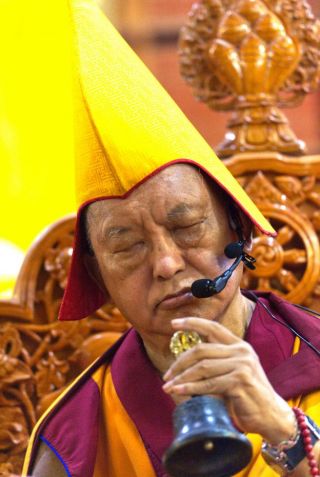
Lama Zopa Rinpoche, Tushita Meditation Centre, Dharamsala, India, September 2018. Photo by Simon Houlton.
Students can find updated versions of Calling the Guru from Afar (Extensive and Brief Versions) and Advice to Correctly Follow the Virtuous Friend with Thought and Action: The Nine Attitudes of Guru Devotion on FPMT.org. Updates include new preferred translations by Lama Zopa Rinpoche and the creation of standalone ebook formats.
Both versions of Calling the Guru from Afar are heartfelt requests for blessings from the guru to realize all the stages of the path to enlightenment as well as a meditations on the guru’s nature. The extensive version was composed by Phabongkha Rinpoche, author of Liberation in the Palm of Your Hand, at the request of Ven. Losang Rabyä. The brief version, Lama Zopa Rinpoche suggests, was composed by Kyabje Trulshik Rinpoche’s root guru, Rongphu Sanggye (Ngawang Tenzin Norbu, 1867–1940/42).
In order to learn the tune to chant the extensive version, students can find two audio recordings of the prayer: one by Lama Zopa Rinpoche and one by Ven. Dechen, a new recording from the retreat in Bendigo, Australia during March-May 2018.
Advice to Correctly Follow the Virtuous Friend with Thought and Action: The Nine Attitudes of Guru Devotion was compiled by the ascetic mahasiddha Tshogdrub Rangdröl and translated by Lama Zopa Rinpoche. Its verses accord with the teachings in Lama Tsongkhapa’s Lamrim Chenmo on correctly devoting to the virtuous friend with the nine attitudes.
Calling the Guru from Afar, including the audio recording of Lama Zopa Rinpoche’s chanting, and Advice to Correctly Follow the Virtuous Friend with Thought and Action: The Nine Attitudes of Guru Devotion are available by donation through the Foundation Store:
https://shop.fpmt.org/Calling-the-Guru-from-Afar-Extensive-and-Brief-Versions-eBook-PDF_p_988.html
https://shop.fpmt.org/Calling-the-Guru-from-Afar–Download_p_2221.html
https://shop.fpmt.org/Advice-to-Correctly-Follow-the-Virtuous-Friend-with-Thought-and-Action-The-Nine-Attitudes-of-Guru-Devotion-eBook-PDF_p_3171.html
Through comprehensive study programs, practice materials, and training seminars, FPMT Education nourishes the development of compassion, wisdom, kindness, and true happiness in individuals of all ages.
8
‘Atisha’s Light of the Path,’ A Living in the Path Module
In the complimentary Living in the Path module “Atisha’s Light of the Path,” Lama Zopa Rinpoche briefly recounts the life story of Atisha and the circumstances under which Atisha composed Light of the Path to Enlightenment, and then explains the three capable beings and how to ensure that our actions become Dharma.
“All the 84,000 teachings, which come in three levels, all are integrated. [The three levels] created so much confusion in Tibet, but Atisha integrated all of this very simply, like lunch; like food made and set on the table for you to eat, so all you have to do is eat. Lama Atisha integrated them all in a few pages, very simply. He made it very clear how all this—the Hinayana, the Mahayana Paramitayana, the Mahayana Secret Mantra Vajrayana—is a graduated practice for one person to achieve enlightenment. There is nothing contradictory for that person. Everything is advice. Everything is practice. All three levels are a graduated practice for one person to achieve enlightenment, presented very simply in a few pages.”
Watch “Like Lunch on the Table” on YouTube:
https://youtu.be/YNpKGPSFjvY
“Atisha’s Light of the Path” is available through the FPMT Online Learning Center:
https://onlinelearning.fpmt.org/course/view.php?id=134
Living in the Path is an online lamrim course taught by Lama Zopa Rinpoche available through the FPMT Online Learning Center:
https://onlinelearning.fpmt.org/course/index.php?categoryid=5
Through comprehensive study programs, practice materials, and training seminars, FPMT Education nourishes the development of compassion, wisdom, kindness, and true happiness in individuals of all ages.
- Tagged: lama atisha, living in the path
1
New! Torma Offering to the Landlord Spirits (Zhidag Torma)
The Torma Offering to the Landlord Spirits (Zigdag Torma) is a common ritual, often done in the context of other more extensive practices such as self-generation sadhanas, burning offerings, land consecrations, and Dharma protector pujas.
The torma offering placates the many spirits who live and own the land around us and beyond, requesting them to create favorable conditions for our practice and activities. Although the practice may be recited by anyone, a tantric initiation into any of the four classes of tantra is required to do the practice in full as the offering can only be blessed on the basis of having self-generated as a deity.
Find Torma Offering to the Landlord Spirits (Zigdag Torma) and other practices by donation in the Foundation Store:
https://shop.fpmt.org/Torma-Offering-to-the-Landlord-Spirits-Zhidag-Torma-PDF_p_3164.html
Through comprehensive study programs, practice materials, and training seminars, FPMT Education nourishes the development of compassion, wisdom, kindness, and true happiness in individuals of all ages.
- Tagged: zhidag torma
25
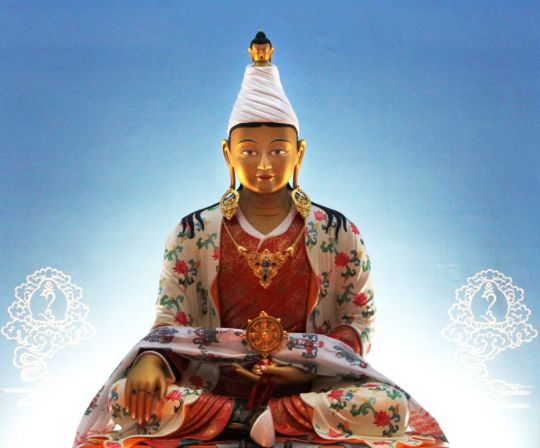
Statue of Dharma King Songtsen Gampo created by Bertrand Cayla, Jokhang, Portland, Oregon, United States, 2011. Photo by Marc Sakamoto.
Two prayers by Dharma King Songtsen Gampo have been translated by Lama Zopa Rinpoche and are now available on FPMT.org.
Prayer to Chenrezig, Compassionate-Eye-Looking One and Prayer of Auspiciousness from the Mani Kabum both come from the Mani Kabum, a collection of teachings attributed to King Sontsen Gampo and focused on Chenrezig.
Dharma King Songtsen Gampo (c. 605-650), traditionally considered an emanation of Chenrezig, is the first of the three great Dharma kings, and is credited with introducing the Dharma to Tibet.
Prayer to Chenrezig, Compassionate-Eye-Looking One and Prayer of Auspiciousness from the Mani Kabum are also available by donation through the Foundation Store:
https://shop.fpmt.org/Prayer-to-Chenrezig-Compassionate-Eye-Looking-One-PDF_p_3137.html
https://shop.fpmt.org/Prayer-of-Auspiciousness-from-the-Mani-Kabum-PDF_p_3136.html
Through comprehensive study programs, practice materials, and training seminars, FPMT Education nourishes the development of compassion, wisdom, kindness, and true happiness in individuals of all ages.
- Tagged: king songtsen gampo
24
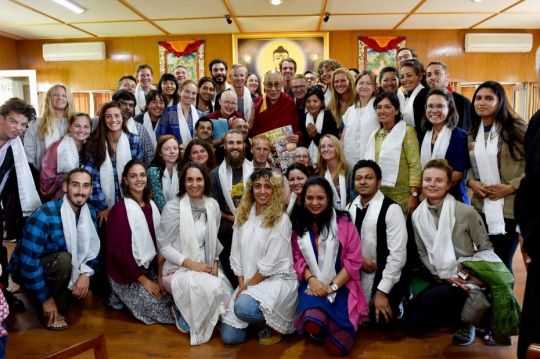
His Holiness the Dalai Lama with March 26-April 4 Introduction to Buddhism students, Dharamsala, India, March 2018. Photo courtesy Office of His Holiness the Dalai Lama.
Ven. Tenzin Kunphen, spiritual program coordinator, and Maria Nobuko Corrales, assistant spiritual program coordinator, Tushita Meditation Centre share an update from Dharamsala, India.
After completing a record-breaking 2017, we are enjoying a year of record-breaking of another sort: teachings and audiences with His Holiness the Dalai Lama!

His Holiness the Dalai Lama with April 11-20 Introduction to Buddhism students and April 12-20 Insight Into Emptiness students, Dharamsala, India, April 2018. Photo courtesy Office of His Holiness the Dalai Lama.
In late March we received an invitation specifically for the students in our Introduction to Buddhism course to come to His Holiness’s temple for a private teaching. This being a first for Tushita, we were overjoyed to facilitate this precious opportunity for our students.
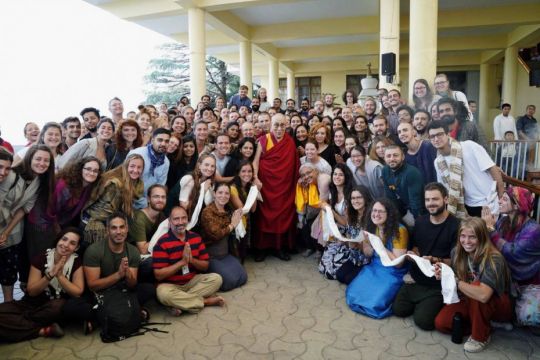
His Holiness the Dalai Lama with May 18-27 Introduction to Buddhism students, Dharamsala, India, May 2018. Photo courtesy Office of His Holiness the Dalai Lama.
This also marked the first time Tushita students as a group were able to have their photo taken with His Holiness.
Our fortune then continued with public audiences in April, May, and June!
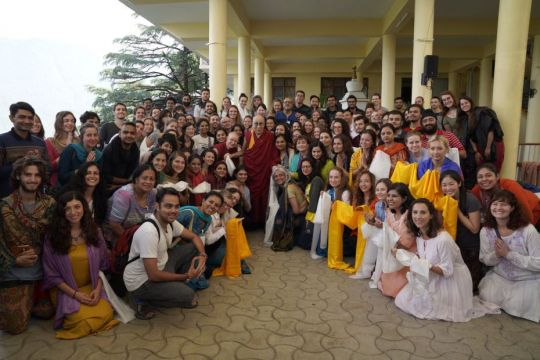
His Holiness the Dalai Lama with June 5-14 Introduction to Buddhism students, Dharamsala, India, June 2018. Photo courtesy Office of His Holiness the Dalai Lama.
On April 16, 2018, while meeting with Indian and foreign tourists at the main Tibetan temple courtyard in Dharamsala, to our greatest delight, His Holiness specifically mentioned Tushita. He advised that our students should study Shantideva’s A Guide to the Bodhisattva’s Way of Life, especially chapters six and eight.
Watch His Holiness mention Tushita on YouTube:
https://youtu.be/DwM-_ECgpaM?t=20m13s
In the first half of 2018, we have already welcomed over 750 students from all over the world for our popular ten-day Introduction to Buddhism courses. Almost all of these courses were completely full, with additional students on waiting lists hoping to get a space in the course.

May 18-27 Introduction to Buddhism students with Ven. Tenzin Kunphen, Ven. Tony Beaumont, and Maya, Tushita Meditation Centre, Dharamsala, India, May 2018. Photo courtesy of Tushita Meditation Centre.
In May we had our largest course, in which we managed to squeeze 122 students!
Even our February course (the first of the season, at the end of our cold winter) had an unusually high turnout.
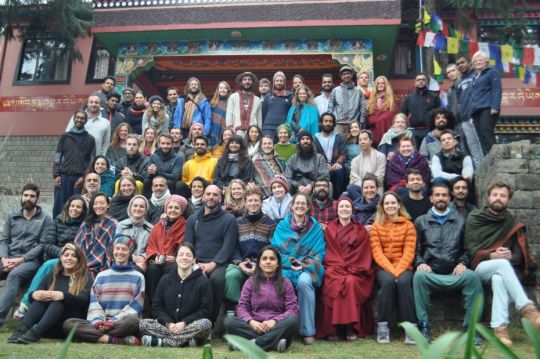
February 20-March 1 Introduction to Buddhism students with Ven. Tenzin Drolma and Maya, Tushita Meditation Centre, Dharamsala, India, May 2018. Photo courtesy of Tushita Meditation Centre.
For those unable to participate in our residential program, we have non-residential programs too. Six days a week we offer morning meditations, which are ever-popular. One day this May we had a whopping 150 students join our morning meditation session! We have also been happy to offer twice-weekly Dharma movie days and regular pujas.
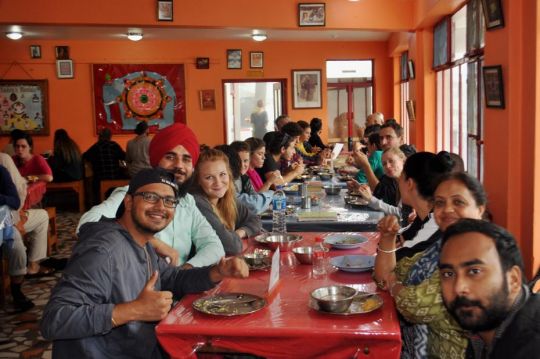
June 20-29 Introduction to Buddhism students, Tushita Meditation Centre dining hall, Dharamsala, India, June 2018. Photo courtesy of Tushita Meditation Centre.
In the short breaks in between residential courses, we were delighted to offer six two-day short courses on How to Meditate led by Shahar Tene, which typically attract around 100 students. These have been a wonderful addition to our program for students unable to commit to a full ten-day Introduction to Buddhism course, as well as a helpful supplement for students before or after their ten-day courses.
For more 2018 highlights, see Tushita News July 2018:
http://tushita.info/news/news-july-2018/
To learn about Tushita Meditation Centre’s student demographics, visit their 2017 report:
http://tushita.info/news/who-are-tushitas-students-nationality-2017/
FPMT.org and Mandala Publications brings you news of Lama Zopa Rinpoche and of activities, teachings, and events from over 160 FPMT centers, projects, and services around the globe. If you like what you read, consider becoming a Friend of FPMT, which supports our work.
- Tagged: his holiness the dalai lama, maria nobuko corrales, tushita meditation centre, ven. tenzin kunphen
18
Lhabab Duchen Is on October 31
Lhabab Duchen, one of the four great holy days of the Buddhist calendar, takes place this year on Wednesday, October 31.
Lhabab Duchen celebrates Guru Shakyamuni Buddha’s return to Earth from the god realm Thirty-Three after teaching Dharma for several months to the gods there, including his mother, Mayadevi, who had died a week after Buddha’s birth and been reborn there. As a merit multiplying day, the karmic results of actions done on this day are multiplied 100 million times. This amazing result is sourced by Lama Zopa Rinpoche to the vinaya text Treasure of Quotations and Logic.
Specific advice from Lama Zopa Rinpoche for practices to do on merit multiplying days can be found on FPMT.org, including advice to recite the Sutra for Remembering the Three Jewels. (Advice for merit multiplying days can also be found in French.) If you choose to recite the Sutra of Golden Light on this special day, you might like to report your recitations using the facility on the FPMT website, which you can find on the Sutra of Golden Light reporting page.
Please keep in mind that according to the late Kyabje Choden Rinpoche, one of Lama Zopa Rinpoche’s gurus, the observation of auspicious days should be according to the date in India, not the date in one’s home country. Therefore, when Lama Zopa Rinpoche is not in India, Rinpoche celebrates merit multiplying days and other auspicious dates according to the time in India.
Special thanks to the Liberation Prison Project for preparing a Tibetan calendar with information on holy days and other important dates for avoiding or engaging in various activities.
Through comprehensive study programs, practice materials, and training seminars, FPMT Education nourishes the development of compassion, wisdom, kindness, and true happiness in individuals of all ages.
- Tagged: lhabab duchen
- Home
- News/Media
- Study & Practice
- About FPMT Education Services
- Latest News
- Programs
- New to Buddhism?
- Buddhist Mind Science: Activating Your Potential
- Heart Advice for Death and Dying
- Discovering Buddhism
- Living in the Path
- Exploring Buddhism
- FPMT Basic Program
- FPMT Masters Program
- FPMT In-Depth Meditation Training
- Maitripa College
- Lotsawa Rinchen Zangpo Translator Program
- Universal Education for Compassion & Wisdom
- Online Learning Center
- Prayers & Practice Materials
- Overview of Prayers & Practices
- Full Catalogue of Prayers & Practice Materials
- Explore Popular Topics
- Benefiting Animals
- Chenrezig Resources
- Death & Dying Resources
- Lama Chopa (Guru Puja)
- Lama Zopa Rinpoche: Compendium of Precious Instructions
- Lama Zopa Rinpoche: Life Practice Advice
- Lama Zopa Rinpoche Practice Series
- Lamrim Resources
- Mantras
- Prayer Book Updates
- Purification Practices
- Sutras
- Thought Transformation (Lojong)
- Audio Materials
- Dharma Dates – Tibetan Calendar
- Translation Services
- Publishing Services
- Teachings and Advice
- Find Teachings and Advice
- Lama Zopa Rinpoche Advice Page
- Lama Zopa Rinpoche: Compendium of Precious Instructions
- Lama Zopa Rinpoche Video Teachings
- ༧སྐྱབས་རྗེ་བཟོད་པ་རིན་པོ་ཆེ་མཆོག་ནས་སྩལ་བའི་བཀའ་སློབ་བརྙན་འཕྲིན།
- Podcasts
- Lama Yeshe Wisdom Archive
- Buddhism FAQ
- Dharma for Young People
- Resources on Holy Objects
- Ways to Offer Support
- Centers
- Affiliates Area
- Teachers
- Projects
- Charitable Projects
- Make a Donation
- Applying for Grants
- News about Projects
- Other Projects within FPMT
- Support International Office
- Projects Photo Galleries
- Give Where Most Needed
- FPMT
- Shop
Translate*
*powered by Google TranslateTranslation of pages on fpmt.org is performed by Google Translate, a third party service which FPMT has no control over. The service provides automated computer translations that are only an approximation of the websites' original content. The translations should not be considered exact and only used as a rough guide.If you are suffering, use it as the cause to bring happiness to others. This way, whatever kind of life experience you have, you use it on the path. There is no interruption to Dharma practice and one’s life is most beneficial.







